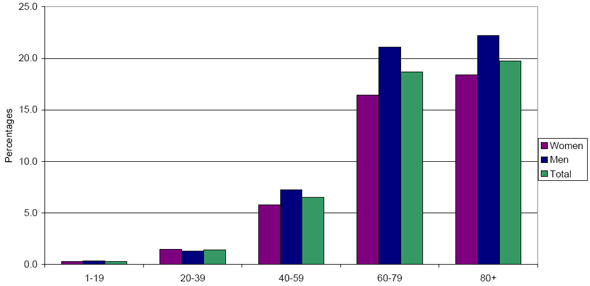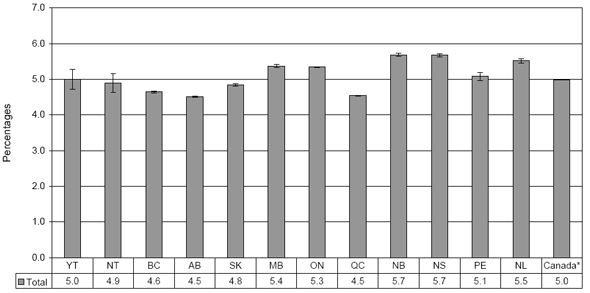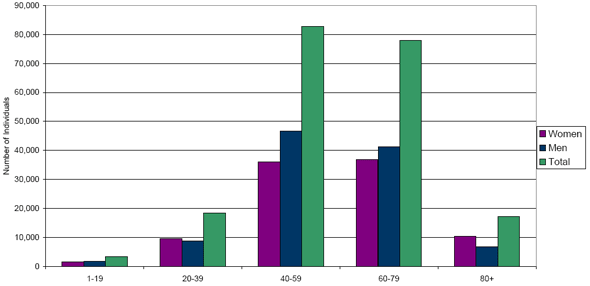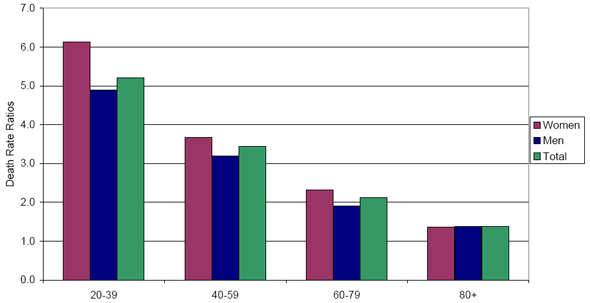Common menu bar links
Institutional links
Diseases & Conditions
Health & Safety
Research & Statistics
Agency Information
Search Box
E-mail this page
The face of diabetes in Canada
In 2005-2006, approximately 1.9 million Canadian men and women had been diagnosed with diabetes. This represents about 1 in 17 Canadians - 5.5 % of all women and 6.2 % of all men1 (Figure 1). In 2005-2006, the prevalence was highest in Newfoundland and Labrador, Nova Scotia and New Brunswick, and lowest in the Yukon, Alberta and Nunavut (Figure 2). The number of people with diagnosed diabetes continues to grow, with almost 200,000 new cases of diabetes diagnosed in 2005-2006 (Figure 3). In addition, it is known that a large number of individuals with diabetes have not been diagnosed and are unaware that they have the disease.
Older Canadians are more likely to have diabetes. In 2005-2006, twenty-two percent of people (approximately 1 in 5) in the 75-79 year old age group had been diagnosed with diabetes. This was almost ten times the proportion seen in Canadian adults aged 35-39 where the prevalence was 2.3%, or 1 in 432 (Figure 1)
Overall, in adults aged 20 and older, death rates for those with diabetes are two to three times greater than those of the general population. Among 20-39 year olds, individuals with diabetes die at a rate more than six times that of the general population, while in the 60-79 year age group the rates are about twice as high (Figure 4).

Source: Public Health Agency of Canada, using NDSS data files contributed by provinces and territories, as of August, 2008
*Data for Nunavut were unavailable.

Source: Public Health Agency of Canada, using NDSS data files contributed by provinces and territories, as of August, 2008
*Data for Nunavut were unavailable.
‡The 95% Confidence Interval shows an estimated range of values which is likely to include the true prevalence rate 19 times out of 20.
*Age-standardized to 1991 Canadian population

Source: Public Health Agency of Canada, using NDSS data files contributed by provinces and territories, as of August, 2008
*Data for Nunavut were unavailable.
‡The 95% Confidence Interval shows an estimated range of values which is likely to include the true prevalence rate 19 times out of 20.
*Age-standardized to 1991 Canadian population

Source: Public Health Agency of Canada, using NDSS data files contributed by provinces and territories, as of August, 2008
*Data for Nunavut were unavailable.
High Risk Populations
Research has shown that Aboriginals and certain populations, such as Asians, Hispanics, and Africans, have a significantly higher risk of developing diabetes. Estimates of the prevalence of diabetes in Aboriginal people have been found to be as much as 3 to 5 times that in non-Aboriginal populations.
- Diabetes in Canada: Highlights from the National Diabetes Surveillance System 2004-2005. Table 2.
- Diabetes in Canada: Highlights from the National Diabetes Surveillance System 2004-2005. Table 2.
